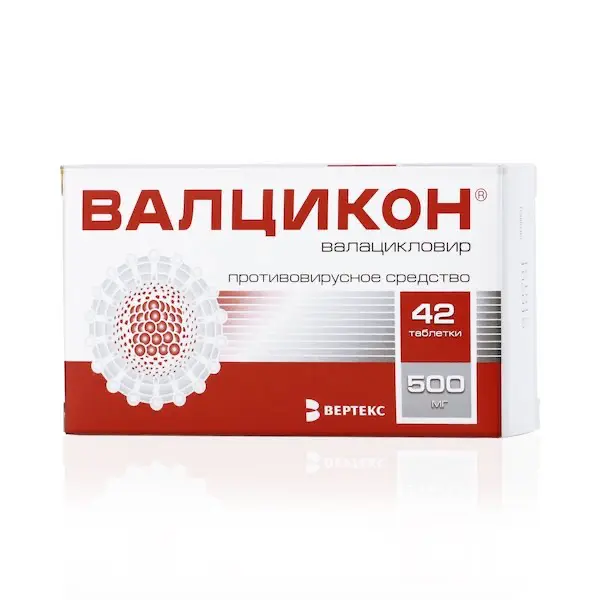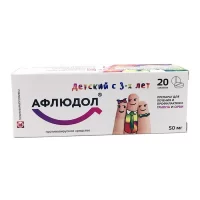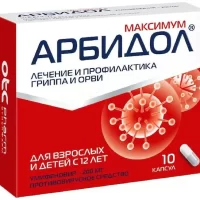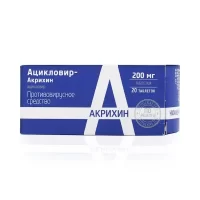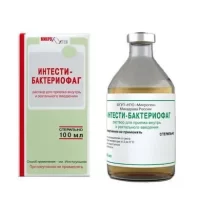Description
Valcyclone Pharmacodynamics
Valacyclovir is a nucleoside inhibitor of DNA polymerase of herpes viruses. It blocks the synthesis of viral DNA and viral replication. In humans, valacyclovir is completely converted to acyclovir and L-valine. Acyclovir in vitro has specific inhibitory activity against herpes simplex virus (HPV) types 1, 2 (Herpes simplex type 1, 2), varicella zoster virus (VZV), cytomegalovirus (CMV), Epstein-Barr virus (VEB) and human herpes virus type 6. Acyclovir inhibits viral DNA synthesis immediately after phosphorylation and conversion to the active form acyclovirtriphosphate. The first stage of phosphorylation occurs with the participation of virus-specific enzymes. For HPV, VZV and VEB viruses, this enzyme is viral thymidine kinase, which is present in virus-affected cells. Partial phosphorylation selectivity is retained in cytomegalovirus and is mediated through the phosphotransferase gene product UL 97. Activation of acyclovir by a specific viral enzyme largely explains its selectivity.
The process of acyclovir phosphorylation (conversion from mono- to triphosphate) is completed by cellular kinases. Acyclovir triphosphate competitively inhibits viral
DNA polymerase and, being a nucleoside analog, is incorporated into the viral DNA, which leads to obligate chain breaking, cessation of DNA synthesis and, consequently, to blocking of virus replication.
In immunocompromised patients, valacyclovir-associated HPV and VZV are extremely rare (less than 0.1%), but can sometimes be found in patients with severe immune disorders, such as bone marrow transplants, patients receiving chemotherapy for malignancies, and HIV-infected patients.
Resistance is due to a thymidine kinase deficiency of the virus, which leads to excessive spread of the virus in the host. Sometimes decreased sensitivity to acyclovir is caused by the emergence of virus strains with disrupted viral thymidine kinase or DNA polymerase structure. Virulence of these varieties of the virus resembles that of its wild strain.
Indications
Adults:
Treatment of herpes shingles (Herpes zoster) (the drug helps to relieve pain syndrome, reduces its duration and percentage of patients with pain caused by herpes shingles, including acute and post-herpetic neuralgia);
treatment of skin and mucous membrane infections caused by Herpes simplex virus type 1, 2, including newly diagnosed and recurrent genital herpes (Herpes genitalis), as well as labial herpes (Herpes labialis);
prevention (suppression) of recurrent infections of the skin and mucous membranes caused by Herpes simplex virus type 1, 2, including genital herpes;
Prevention of genital herpes virus transmission to a healthy partner, when using the drug as a suppressive therapy in combination with safe sex.
Adults and children aged 12 years and older:
Prevention of cytomegalovirus (CMV) infection as well as acute transplant rejection reactions (in patients with kidney transplants), opportunistic infections and other herpesvirus infections
Contraindications
Hypersensitivity to valacyclovir, acyclovir or any other component of the drug
HIV infection with a CD4+ lymphocyte count of less than 100 per 1 µl;
childhood (under 12 years of age for prophylaxis of cytomegalovirus infection after transplantation, under 18 years for other indications).
With caution
hepatic and/or renal insufficiency;
old age;
hypohydration;
concomitant use of nephrotoxic drugs;
pregnancy;
breastfeeding period;
clinically evident forms of HIV infection.
Administration in pregnancy and during breast-feeding
Pregnancy
There are limited data on the use of valacyclovir in pregnancy. Valacyclovir is used only when the potential benefit to the mother outweighs the possible risk to the fetus.
Reported pregnancy outcomes in women taking valacyclovir or acyclovir (the active metabolite of valacyclovir) showed no increase in birth defects in children compared to the general population. Because the registry included a small number of women who took valacyclovir during pregnancy, no reliable and definitive conclusions about the safety of valacyclovir in pregnancy can be drawn.
Breastfeeding period
Acyclovir, the main metabolite of valacyclovir, is excreted with breast milk. After oral administration of valacyclovir at a dose of 500 mg, the Cmax of acyclovir in breast milk
0.5-2.3 times (on average 1.4 times) higher than the corresponding acyclovir concentrations in maternal blood plasma. The mean concentration of acyclovir in breast milk was 2.24 µg/mL (9.95 µmol/L). If the mother takes valacyclovir orally at a dose of 500 mg twice daily, the baby will be exposed to the same amount of acyclovir as if acyclovir were taken orally at a dose of about 0.61 mg/kg/day. The T1/2 from breast milk is the same as that from blood plasma. Valcicon® should be used with caution in lactating women.
Dosage and administration
- Inside, with water and regardless of the meal.
- Treatment of herpes zoster (herpes zoster).
- Adults:
- The recommended dose is 1000 mg 3 times daily for 7 days.
Treatment of infections caused by HPV (Herpes simplex) - Adults:
- The recommended dose for episode therapy is 500 mg 2 times daily for 5 days.
In more severe cases of disease onset, treatment should be started as soon as possible, and its duration may be increased from 5 to 10 days. In cases of relapses, treatment should be continued for 3 or 5 days. For recurrent HPV, it is ideal to prescribe valacyclovir in the prodromal period or immediately after the onset of the first symptoms of the disease. - Alternatively, for the treatment of labial herpes, Valacyclovir is effective at a dose of 2 g twice daily. The second dose should be taken approximately 12 hours (but not earlier than 6 hours) after the first dose. With this dosing regimen, the duration of treatment is 1 day.
- Therapy should be started when the earliest symptoms of labial herpes appear: tingling, itching and/or burning.
- Prevention (suppression) of recurrent infections caused by HPV
- Adults:
In immunocompromised patients, the recommended dose is 500 mg once daily.
In immunocompromised patients, the recommended dose is 500 mg twice daily. - Prevention of genital herpes transmission to a healthy partner
In infected immunocompetent individuals with no more than 9 recurrences per year, the recommended dose of valacyclovir is 500 mg once daily for one year or more, daily. - No data are available on prevention of infection in other patient populations.
Prevention of cytomegalovirus (CMV) infection after transplantation - Adults and adolescents 12 years of age and older:
- The recommended dose is 2 g 4 times daily, administered as soon as possible after transplantation. The dose should be reduced depending on creatinine clearance (CK). The duration of treatment is 90 days, but in high-risk patients the course of treatment may be extended.
- Special patient groups
Patients with impaired renal function:
– Treatment of herpes zoster and HPV infections, prevention (suppression) of recurrent HPV infection, prevention of transmission of genital herpes to a healthy partner
It is recommended that the dose of Valacyclovir be reduced in patients with a significant reduction in renal function (see instructions). Adequate hydration should be maintained in such patients. - Patients on hemodialysis are recommended to use valacyclovir immediately after the end of hemodialysis session in the same dose as patients with CK less than 15 ml/min.
– Prevention of cytomegalovirus (CMV) infection after transplantation
The Valacyclovir regimen in patients with impaired renal function should be established according to the instructions. - CK should be determined frequently, especially during periods when renal function changes rapidly, such as immediately after transplantation or graft engraftment, and the dose of valacyclovir should be adjusted according to CK rates.
- Patients with impaired liver function
In adult patients with mild to moderate hepatic dysfunction with preserved synthetic function no dose adjustment of valacyclovir is required. Pharmacokinetic data in adult patients with severe hepatic impairment (decompensated cirrhosis), impaired hepatic synthetic function and presence of portocaval anastomoses also do not indicate the need to adjust valacyclovir dose, but clinical experience with this pathology is limited. - Children under 12 years of age
There are no data on the use of Valcicon® in children.
Elderly patients - No dose adjustment is required, except in patients with significant renal dysfunction.
- Adequate water-electrolyte balance should be maintained.

